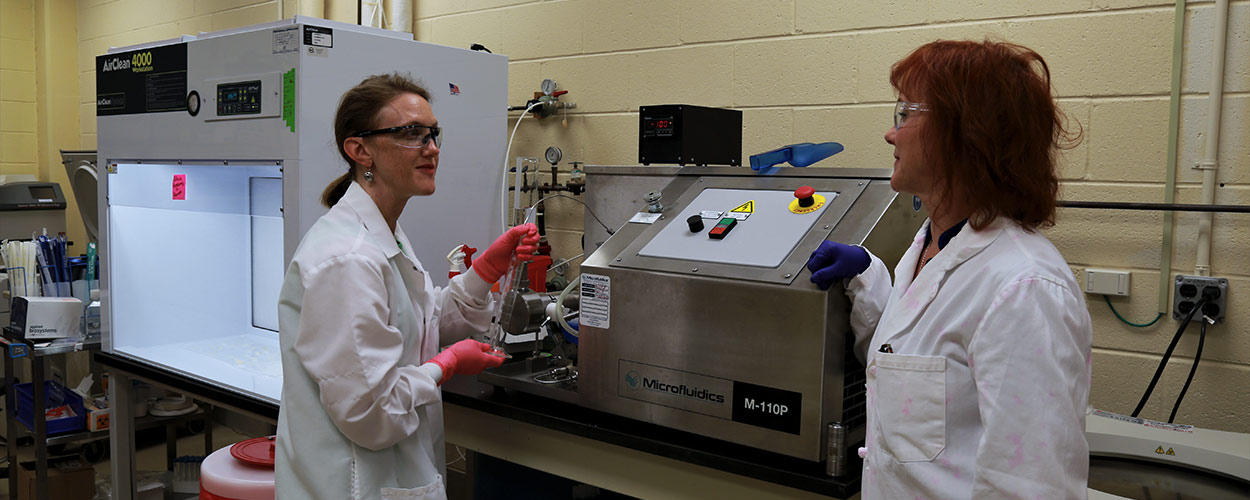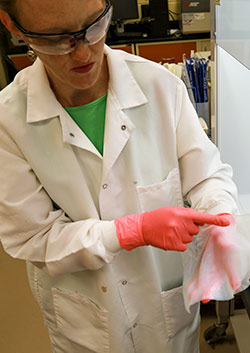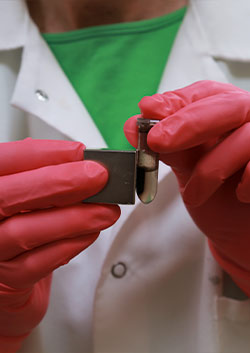Army Researchers Look to Biology for Next-Gen Power Alternatives
Army Researchers Look to Biology for Next-Gen Power Alternatives
By Gay Pinder
Imagine having the ability to grow electronic components using living bacteria. That idea was the inspiration that biologist Alena Calm and research scientist Kelley Betts at the U.S. Army Combat Capabilities Development Command (CCDC) Chemical Biological Center drew upon to come up with their FY19 Innovative Development of Advanced Employee Solutions Program project.
Together, the scientists are developing technologies that leverage the unique properties of bacterial magnetosomes– biologically-derived nanoparticles that have a number of superior properties that include high chemical purity, low toxicity, a high degree of crystallographic perfection and permanent magnetization.
Mission Focused
Knowing that the warfighter is routinely burdened with the weight of electronic devices designed for communication, agent threat detection and other field purposes, Betts and Calm considered the idea of using magnetosomes to develop the next generation of lightweight electronic devices.
“A lot of threat agent detecting sensors are going paper-based because they are logistically easier to use,” Calm said. “Chemical sensors can be bulky and require power to operate. Energy sources, even triple “A” batteries, add weight to the warfighter’s pack which is a logistical challenge many researchers are seeking to overcome.”
“It’s weight. It’s logistics. It’s all of the above,” added Betts. “Our thinking was to help make the power sources used in remote or field-forward sensor applications more paper-based, bringing the idea of lightweight – perhaps even disposable – electronics to the forefront of research.”
“We began to think; so how are we going to come up with things that are lighter and cheaper?” Calm said.
The Research
Participating in the Center’s Biological Engineering for Applied Materials Solutions (BEAMS) nanocellulose competition last summer led Calm and Betts to speculate how they could leverage what they had learned from the competition for their current work with magnetosomes.
“That’s where we started brainstorming and working with the idea of magnetically infused paper,” Calm said. “One crazy thought led to another,” she said, ending with Betts coming up with the idea of a biologically-derived transformer core.
“The idea is that you could make transformers really, really small, even as thin as a piece of paper,” Calm reiterated.
“It’s very out there. Very Star Trek,” Betts chimes in.
“But in theory, it will work.” Calm finishes.
The first step on their futuristic journey required proof that the team could coax the magnetotatic bacteria M. gryphiswaldense to produce magnetite nanoparticles.
Long strings of membrane-bound magnetite nanoparticles called magnetosomes are produced within the bacteria when they are deprived of oxygen. In their search for oxygen, the strings of magnetosomes serve as a kind of internal compass that lets them navigate to a more oxygen-rich environment using the Earth’s geomagnetic field.
It takes countless strings of magnetosomes to further Calm’s and Betts’ goal. Growing the bacteria on a bigger scale has been successful, with 20 liter batches grown by colleague Michael Kim, Ph.D., at the large-scale fermentation facility at the Center’s biotechnology laboratory.
“The fact that we have a fermentation suite that has up to a 1,500 liter fermenter means that we have room to grow,” Calm said. “And using the 20 liter fermenter we have shown that we can scale-up.”
The two researchers have their heads together in the current phase of their study, along with MUSIP intern Orshuntis Cross, building an actual laminated transformer core by alternating layers of non-conductive nanocellulose and magnetic magnetosomes.
Many of today’s electronics such as computers and cell phone chargers rely on the use of transformers to make the movement of electrical energy between two or more circuits more efficient.
“We recalled that if you make a transformer core out of a solid piece of metal, it can develop small eddy currents which can cause the transformer to lose energy,” Betts explained. “But if you use laminated layers of conductive and nonconductive sheets to make the core, these currents get really small, and the transformer doesn’t lose as much power.”
With that idea, Betts and Calm theorized perhaps alternating layers of non-conducting nanocellulose and magnetic magnetosomes could work together to make the first, ultra-thin, biologically-grown transformer.
“We are going to grow our non-conductive nanocellulose layer,” Calm explained, “and then we’ll overlay it with a culture of magnetic bacterial magnetosomes that will be guided with powerful magnets into a pattern.”
The resulting pellicle or thin film will then be processed, dried, and cut and/or folded into a transformer core comprised of paper-thin alternating conductive and non-conductive layers.
“We’ll then test the transformer by measuring the output of the circuits,” Calm said. “It should increase the electrical output compared to our control that would be wrapped with just plain nanocellulose layers without the magnetosomes in between.”
“The dream is that with these kinds of living materials, we’re changing the paradigm,” Betts said.
“It’s not a metal. It’s something that’s alive and maybe these could, down the line, work into materials that could self-repair.”
Currently, the medical field is investigating magnetosomes for applications such as medical imaging, drug delivery and cancer research.
“This is just one strain of bacteria that we are working with,” Calm said. “There are many. They come in different shapes and sizes and sequester different metals like gold and silver. Years down the line you may want a nanoparticle that’s a certain size or a certain shape and a certain metal.”
A Green Solution
But for now the two researchers are content to work with the magnetosomes produced by M. gryphiswaldense, nanoparticles that have the added benefit of being greener to generate.
Unlike their synthetic counterparts, magnetosome nanoparticles are more environmentally friendly to produce, requiring much less energy for production and no hazardous chemicals for their fabrication.
“If you make nanoparticles synthetically, it’s a dirty business,” Calm said. “They are not environmentally friendly to produce, whereas biologically-derived magnetosomes are. They are found in the environment, and can just go back to the earth when we’re done with them.”
Betts and Kim have also authored a proposal to research the use of nanoparticles in reclaiming rare earth.
“They’ve used them to bio-remediate so maybe we could use them to reclaim rare earth elements from electronic waste,” Betts said. “We could take the rare earth and incorporate it into the nanoparticle, making them more magnetic, more powerful.”
Betts and Calm said the project serves two purposes. It not only serves the warfighter but also meets an Army directive of developing greener solutions.
Versatility
In addition, because biologically-derived magnetosomes are produce in a pearl-like strand, they have unique characteristics over synthetic nanoparticles that generally produce individually, not in strands.
Because magnetosomes also have membranes, researchers can genetically engineer them or chemically attach enzymes to make the natural nanoparticle do even more.
Moving Forward
If their circuit output test proves successful, the two will next try to use the transformer to create paper-based circuitry. But before that can happen, they will need more funding.
Already, one major defense contractor has contacted the pair to discuss ways to grow the magnetosomes faster. Betts and Calm are eager to continue their research.
“It’ll be really interesting because it is a proof of concept project that will hopefully spark the interest of other scientists who see the work that we’re doing and will want to collaborate,” Calm said.
Given that the convergence of material science and biological engineering has seen significant interest and investment by the Department of Defense, Calm and Betts are hoping their efforts will help towards the development of never-before-seen materials that are able to meet the unique requirements and challenges of the defense environment of the future.
Researchers Calm and Betts confer while breaking down cell membranes using a microfluidizer. (Photos by Shawn Nesaw.)



